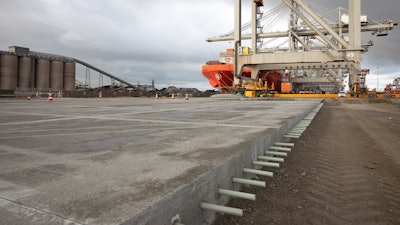The Benefits of Using Composites in Construction Materials
The Benefits of Using Composites in Construction Materials
Blog Article
Opening the Ecological Benefits of Recycled Compounds in Construction and Style
In the world of building and layout, the usage of recycled compounds holds considerable assurance for enhancing sustainability methods and reducing environmental influence (composites). By including these innovative products, there is a prospective to resolve important issues such as waste minimization, energy preservation, and a decline in carbon footprint. The change towards an extra lasting future in these industries depends upon unlocking the full possibility of recycled compounds. This conversation will certainly explore the multifaceted benefits and difficulties related to incorporating recycled compounds into building and construction and layout, offering a peek into the transformative possibilities that lie ahead.

Environmental Effect Decrease
The decrease of environmental impact through using recycled compounds in building and style plays a crucial duty in lasting methods. By including recycled compounds into building products, the building industry can significantly lower its carbon impact and add to an extra green future. These lasting materials, made from repurposed plastics, timber fibers, or various other recycled aspects, offer a practical alternative to conventional construction products without jeopardizing on top quality or durability.
Recycled compounds assist divert waste from garbage dumps and reduce the demand for drawing out resources, therefore saving all-natural resources. Additionally, the manufacturing procedure of these compounds typically consumes less energy and releases fewer greenhouse gases compared to creating virgin materials (composites). This shift in the direction of utilizing recycled compounds not only reduces environmental injury however additionally promotes a round economy by motivating the reuse of materials that would otherwise be thrown out
Waste Minimization
With an emphasis on reducing waste in building and construction and design, the combination of recycled compounds provides a lasting service to lower environmental effect. Waste reduction is a critical facet of lasting practices, and making use of recycled composites provides a chance to attain this goal efficiently. By making use of products that have currently offered their initial purpose, such as recycled plastics or recovered timber fibers, the construction and layout sectors can substantially reduce the amount of waste created and sent out to land fills.
Recycled composites have the potential to divert considerable quantities of waste from conventional disposal approaches, contributing to an extra circular economic situation where sources are utilized effectively. Furthermore, the manufacturing process of recycled composites commonly eats less energy and creates fewer emissions contrasted to virgin materials, better reducing the environmental impact of building and layout jobs.
Implementing waste minimization strategies through the unification of recycled compounds not just helps in conserving natural sources yet likewise promotes a more lasting strategy to structure and making for a greener future.
Power Conservation
Incorporating recycled compounds not just reduces waste in building and design yet additionally plays an important role in boosting power conservation techniques within the market. Making use of recycled compounds in building and construction can dramatically add to power conservation via numerous ways. First of all, the production of virgin materials commonly needs substantial power inputs, whereas utilizing recycled compounds takes in much less energy, thus reducing total energy intake. Furthermore, incorporating recycled compounds can contribute to far better insulation buildings in buildings, lowering the requirement for excessive heating or air conditioning, and consequently lowering energy use for climate control. The light-weight nature of many recycled composites can lead to lighter frameworks, requiring much less power for transportation and setup. By advertising the use of recycled composites in construction and style, the industry can make considerable strides in the direction of accomplishing power performance and minimizing its carbon impact, ultimately contributing to a much more lasting built environment.
Carbon Impact Decrease
Enhancing sustainability techniques with the application of recycled compounds in building and construction and layout considerably decreases the carbon footprint of the sector. By including recycled products into the production of compounds, the demand for virgin resources decreases, resulting in lower power intake and greenhouse gas discharges related to traditional production procedures. This reduction in carbon footprint is crucial in combating climate change and advertising a much more eco-friendly technique to building and layout.
The carbon impact decrease achieved with the fostering of recycled compounds aligns with the worldwide press in the direction of sustainable methods and the decrease of commercial emissions. Eventually, by focusing on the assimilation of recycled compounds, the market can make considerable strides in lowering its carbon footprint and contributing to a much more lasting future.
Lasting Future
The assimilation of recycled compounds in building and design not just addresses immediate ecological issues yet likewise lays a strong structure for a sustainable try here future in the sector. By integrating recycled compounds into structure materials and items, the construction and layout industries can considerably decrease their dependence on virgin resources, leading to a much more circular economic situation. This shift in the direction of sustainability is important for alleviating the environmental effect of traditional building practices, which commonly cause high levels of waste generation and source depletion.

Verdict
To conclude, recycled compounds supply significant environmental benefits in building and construction and layout by reducing environmental influence, decreasing waste, conserving power, lowering carbon impact, and advertising a lasting future. Accepting using recycled composites can contribute to a more environmentally-friendly technique to building and design, inevitably causing a more sustainable and greener future for all.
The reduction of environmental influence with the usage of recycled composites in construction and layout plays a critical duty in lasting practices.With an emphasis on lessening waste in building and design, the assimilation of recycled composites offers a lasting service to decrease ecological effect. By promoting the usage of recycled composites in building and construction and style, the industry can make substantial strides in the direction of attaining power effectiveness and reducing its carbon impact, eventually adding to an extra sustainable constructed atmosphere.

Report this page